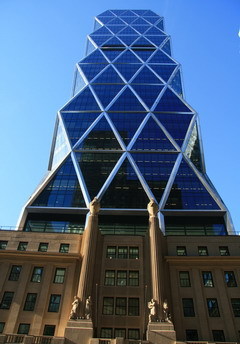Retail designers come to this industry from various walks of life and points of view, equipped with degrees in art, architecture, theater, marketing, fashion, even psychology.
We were drawn to retail design because of our passion, drive and creative spirit. In the early days, we lifted, pulled, hoisted and hung. We motored around 200,000 square feet of retail space with cunning and grace as we trimmed and displayed. And we earned our degree.
The retail venue became our extended campus. We rolled up our sleeves and learned our craft in the main aisle, the studio and the corner window. Our “professors” had names such as Gene Moore, Henry Callahan and Bob Benzio. Being immersed in the business of fashion, we recognized that change was inevitable, the lifeblood of our industry. Those who moved forward embraced change. Those who moved even further forward sought change.
Inspiration Abounds in New York
What you find, though, is that in most major U.S. cities, you don’t have to seek change – it’s all around. That’s certainly true if New York is your laboratory. Inspiration abounds, on the runways and in the showrooms, museums and retail establishments. Additionally, there’s the architectural splendor that is the hallmark of this great town. The canyons of concrete and steel offer up a wonderful classroom of form, function and exciting expression. Architecture, like retail, stands as a mirror to our society and our culture. The flavor of the times is captured in our buildings as well as our stores. The nuances and subtleties of any period of architectural expression are clearly relevant sources of inspiration. You just have to open your eyes.
In New York, that means the powerful geometries and striking relationships of mass and form juxtaposed in horizontal and vertical projections on the Lever House Building by Skidmore, Owings & Merrill on East 53rd Street. Its innovative positioning and clean line clearly complement the Unilever brand, the 120-year-old multinational soap company.
Diagonally across Park Avenue is Mies van der Rohe’s groundbreaking Seagram Building. Its bold vertical thrust of bronze and glass stands regally on an open-air granite plaza, providing an unmistakable dynamic to Park Avenue’s architectural esplanade.
Walk two short blocks for an astonishing study in contiguous relationships as the original art deco RCA Building and the Byzantine-inspired St. Bartholomew’s Church occupy adjacent sites. The unexpected marriage of disparate styles is masterfully achieved by the color and quality of brick and stone.
Creative Combo on 57th Street
Then, for the most striking current example of New York in all its creative flux, take a cross-town bus. The Hearst tower on West 57th Street at Eighth Avenue (near Columbus Circle) is an astonishing example of polarity. Its art deco base, built in 1928, is brilliantly melded to the 21st Century tower that was added on last year, with its incredible diagonal-grid design. The powerful lesson to retail designers: Don’t be afraid to change, innovate, modernize, improve anything – even what has already been working.
Heading downtown, revival seems to be the buzzword, as visionary retailers reclaim the once-proud department store buildings that graced the historic Ladies’ Mile district of Chelsea in the gaslight era. Bed Bath & Beyond has moved into the Siegel-Cooper Department Store space on Sixth Avenue and 18th Street. Barnes & Noble is in the old Italianate, cast iron Adams Dry Goods Store on Sixth Avenue and 20th Street.
Fashion teaches us that what goes around comes around. The dynamics of this revitalized section of Manhattan are as relevant as a Third Avenue billboard linking Audrey Hepburn’s 1950s style and grace to Gap’s skinny pant. Analogously, how compelling are the narrow streets of SoHo, with its Palace de Prada and downtown Bloomingdale’s on cobblestones, cast iron windows and vertical architecture calling out a historic period long gone?
Cities must grow and evolve (just as the retail business must), and often it is the spirit and vision of retail’s brightest that serve as the catalyst for that growth. Urban renewal more often than not is fueled by the merchant princes of the day. The Coliseum at Columbus Circle once featured car shows and boat shows. Today, the Time Warner Center at the same location gives us Whole Foods, where designer melons and couture cucumbers are front and forward, and the Samsung Experience, where we engage the latest interactive technologies.
Street-Level Studies
New York always has so much education to offer young designers, from Frank Gehrey’s new venture overlooking the Hudson to Apple’s jewel on 59th Street.
I may have earned my undergraduate education in retail’s main aisle. But today, I conduct my postgraduate study on the sidewalks of New York.
Eric Feigenbaum, VM+SD’s New York editor, serves on the faculty of both the Fashion Institute of Technology (FIT) and the Laboratory Institute of Merchandising (LIM) in New York. He is a veteran of retail design and a founding member of PAVE.


 Photo Gallery1 week ago
Photo Gallery1 week ago
 Headlines7 days ago
Headlines7 days ago
 Headlines1 week ago
Headlines1 week ago
 Headlines2 weeks ago
Headlines2 weeks ago
 Headlines1 week ago
Headlines1 week ago
 Designer Dozen2 weeks ago
Designer Dozen2 weeks ago
 Designer Dozen5 days ago
Designer Dozen5 days ago
 Headlines7 days ago
Headlines7 days ago









